Artists
Frank Stella, American Artist Who Moved from Proto-Minimalism to Extreme Abstraction, Dies at 87
"What you see is what you see," he famously said of his work.
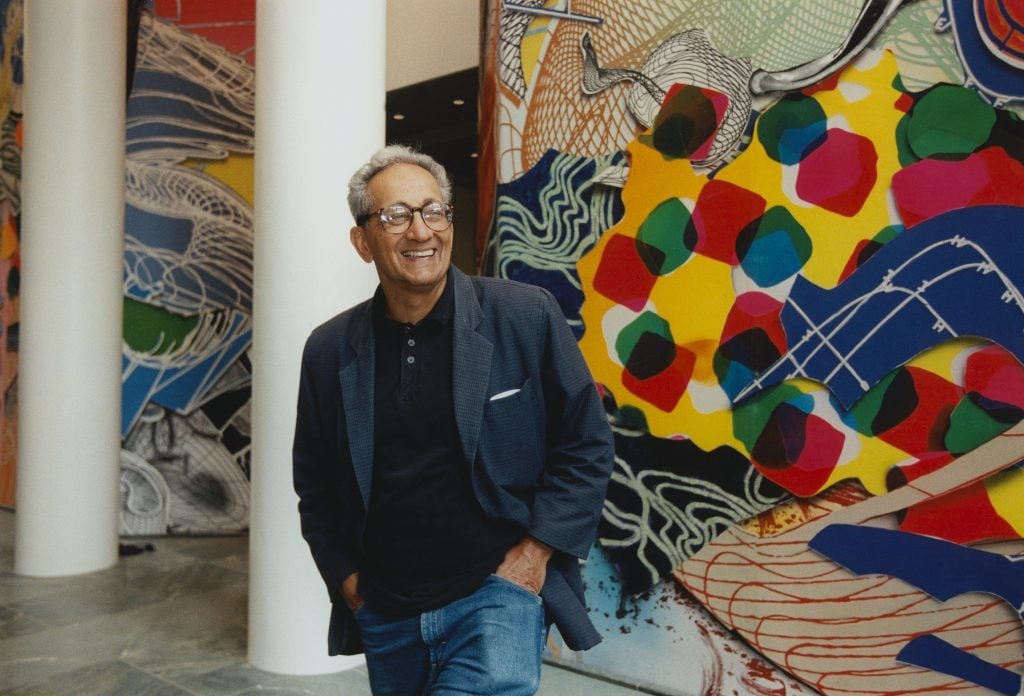
"What you see is what you see," he famously said of his work.

Andrew Russeth

Artist Frank Stella, who redirected the course of vanguard art in the 1950s and 1960s with spare, expressionless, but indelible abstract paintings, helping to usher in the style that came to be known as Minimalism, died today at the age of 87. The cause was lymphoma, his wife, Harriet E. McGurk, told the New York Times.
In late 1958, at the age of 22, Stella began using a house painter’s brush to apply black matte paint to canvases in simple configurations, one straight, parallel line after another, leaving only a faint white space between them. Like Jasper Johns’s paintings of American flags, which Stella had seen, his “Black Paintings” seemed to foreclose the grand gestures of the reigning Abstract Expressionists. “What you see is what you see,” he famously said of his work in a 1964 interview alongside fellow artists Donald Judd and Dan Flavin.
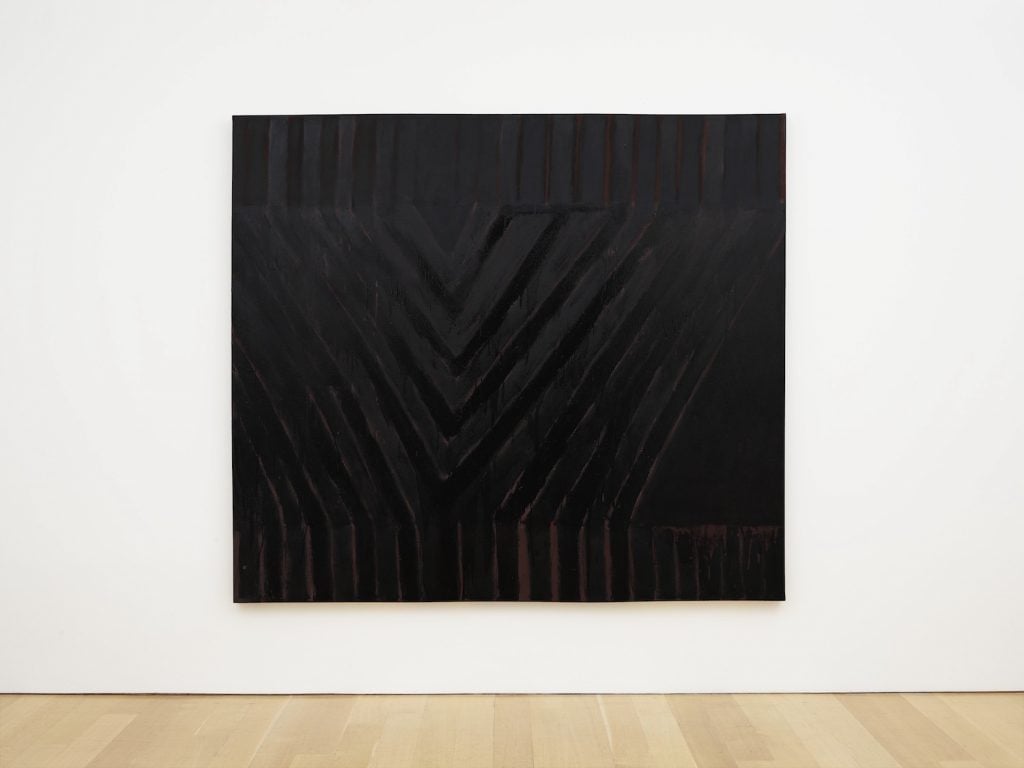
Frank Stella, Delta (1958). Image courtesy Yares Art.
The “Black Paintings” contain knotty contradictions. Their construction is matter of fact, and plainly evident, but they are also smoky and foreboding, even deathly, in effect. Stella gave them titles like Die Fahne hoch! (“Raise the flag,” the Nazi Party’s anthem) and Arundel Castle, the 11th-century English landmark. They debuted in a legendary group show at the Museum of Modern Art in New York at the end of 1959, “16 Americans,” which also included Johns, Louise Nevelson, Ellsworth Kelly, and others key artists.
Stella was on his way, and he would soon become one of his era’s most celebrated figures. The Museum of Modern Art staged a retrospective of his work in 1970 and another in 1987. The Whitney Museum did the same in 2015. In 1964, not yet 30, he was among the artists who represented the United States at the Venice Biennale. The list of his solo shows on his official CV runs more than seven pages. In 2009, President Barack Obama awarded him the National Medal of Arts, praising “his sophisticated visual experiments—often transcending boundaries between painting, printmaking, and sculpture.”
Over a career that spanned more than 65 years, Stella was seemingly indefatigable, always on the hunt for new visual splendor, and he infuriated some portions of the art world with his protean endeavors, as he left his earlier restraint far behind. Lecturing at Pratt Institute in Brooklyn in 1960, at the age of 24, he laid out what would become his life’s mission. “There are two problems in painting,” he said. “One is to find out what painting is and the other is to find out how to make a painting.”
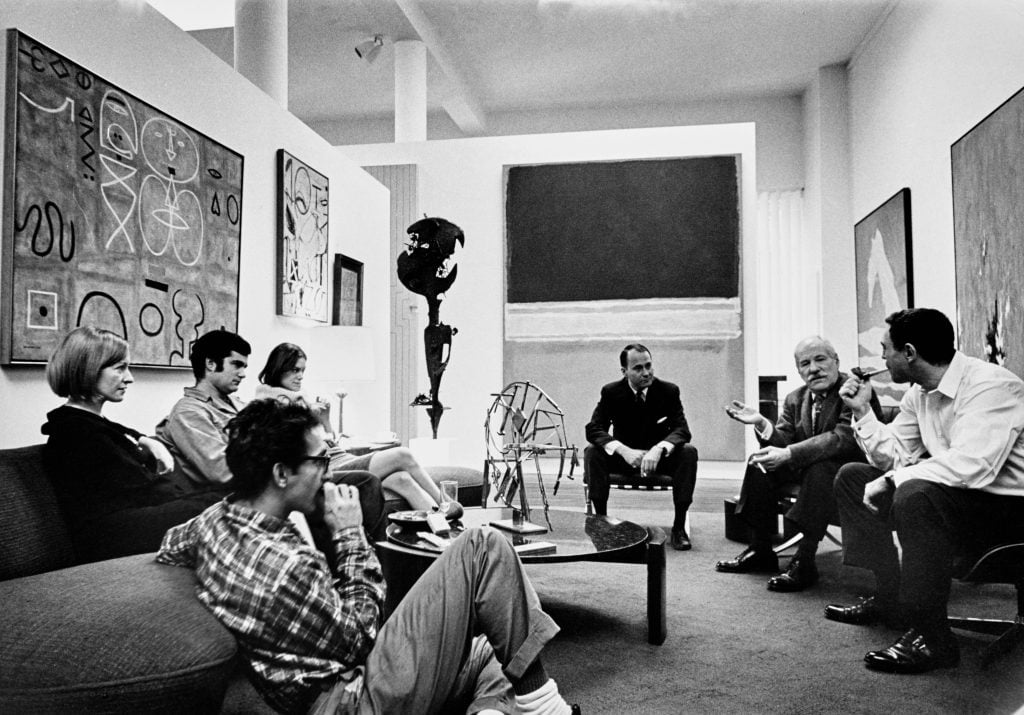
Frank Stella, his wife Barbara Rose, Larry Poons, Lucinda Childs, Wilder Green, Barnett Newman and William Rubin, in Rubin’s apartment, surrounded by artwork by Hans Hoffman, Adolph Gottlieb, Willem de Kooning, Andre Masson, Herbert Ferber, Mark Rothko, Robert Motherwell, Clyfford Still, and David Smith. Photo: William Grigsby/Condé Nast via Getty Images.
Frank Philip Stella was born in Malden, Massachusetts, on May 12, 1936. His father was a gynecologist, and his mother a homemaker. Both painted. The future superstar served as a kind of artist assistant in his early years. “My father would make me sand the floor; we had to do the sanding and scraping before you could hold the brush and then paint on the wall,” Stella told T: The New York Times Style Magazine. He started making his own paintings at 14.
After high school at the prestigious Phillips Academy, in Andover, Massachusetts, where the Minimalist sculptor Carl Andre was a classmate, Stella enrolled at Princeton University, studying history while painting. His teachers included art historian William Seitz and painter Stephen Greene. Following graduation in 1958, he decamped for New York, settling on the Lower East Side.
Stella’s early series seem to unfold steadily, one after another, with a preordained logic, unspoken rules yielding paintings that are flat, symmetrical, and repetitious. The “Black Paintings” led to “Copper” and “Aluminum” paintings, some made on canvases of unusual shapes. Next came concentric squares in a panoply of colors and large “Protractor” works (1967–71) with curving edges, interlocking lines, and neons hues.
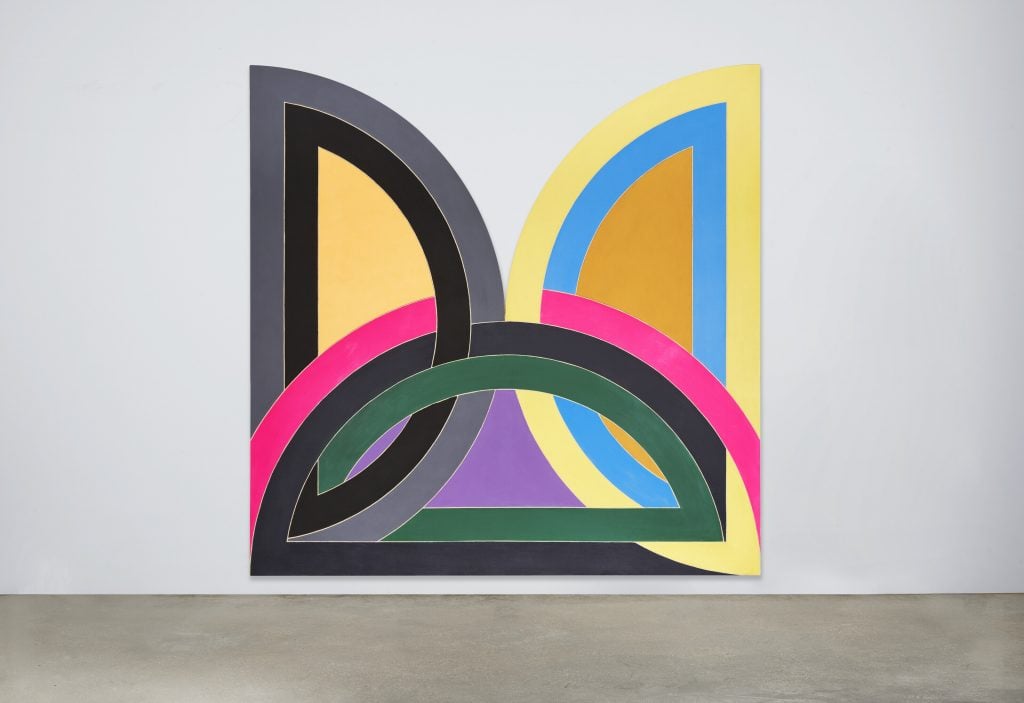
Frank Stella, Abra I (1968). Courtesy of Christie’s Images, Ltd.
These works are utterly extroverted and confident but still controlled—all clean lines and sharp edges. Describing his view of his Ab-Ex forebears in those early years, in an essay in the mid-1980s, Stella wrote. “I sensed a hesitancy, a doubt of some vague dimension which made their work touching, but to me somehow too vulnerable.”
By the early 1970s, Stella was embracing ever more unusual shapes and color palettes, as in his “Polish Village” series, which have relief elements that push out into space. They were inspired by photographs he saw of wooden synagogues in the country that were destroyed by the Nazis. “The carpentry of the synagogues is incredibly sophisticated on a formal level,” he told Artforum in 2016. “The interlockingness—the complex geometric connectedness of each part of the building, which is visible in the photographs—really attracted me.”
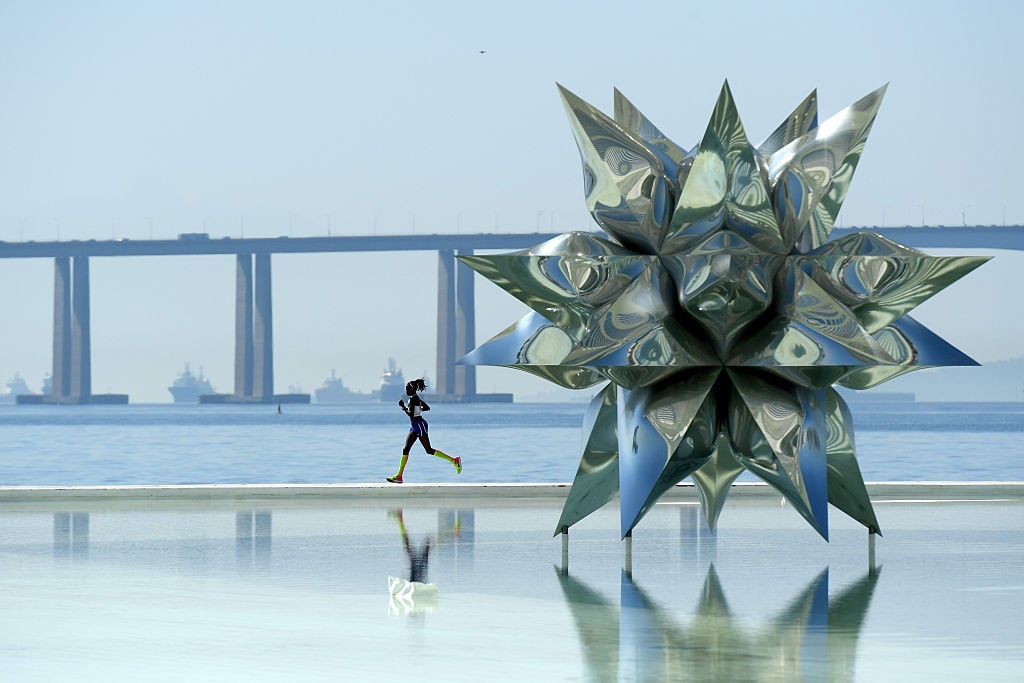
A marathon competitor runs past Frank Stella’s Puffed Star at the Olympics in Rio de Janeiro in 2016. Photo by Matthias Hangst/Getty Images
And then, in the mid-1970s, Stella’s waved goodbye to his rational structures, diving decisively into new, idiosyncratic approaches. Swirls, nets, and scrawls of color replace solid planes; elements start jutting from canvases in every direction. Wall-hung works evolved into fantastical sculptures.
Conceptual modes were in vogue at the time, and influential academics were declaring the end of painting. Stella’s unorthodoxy exasperated them. Writing in 1981 in the journal October, Douglas Crimp declared that the artist’s “late 1970s paintings are truly hysterical in their defiance of the black paintings; each one looks like a tantrum, shrieking and sputtering that the end of painting has not come.”
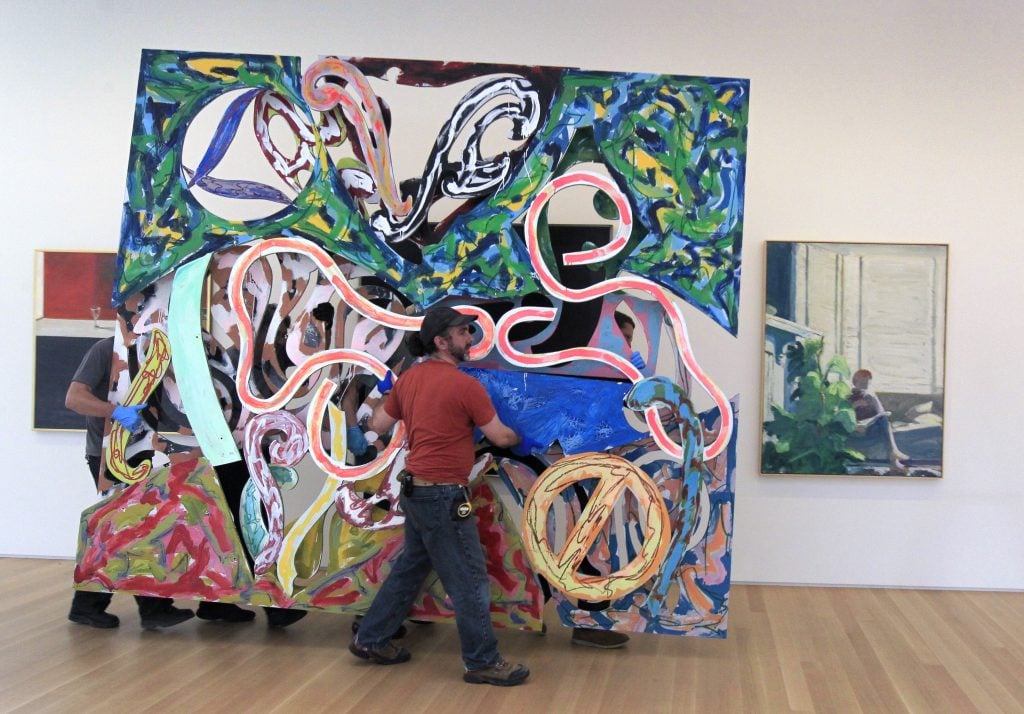
Art handlers carry Frank Stella’s Zeltweg (1981). Photo: Paul Chinn/The San Francisco Chronicle via Getty Images.
Gloriously eccentric Stellas now fill the lobbies of corporate office buildings (some of the only places that can fit his largest works), like 599 Lexington Avenue and the recently opened 50 Hudson Yards in Manhattan. Freestanding sculptures, some produced with the aid of computer technology, dot sculpture gardens and public plazas, including the one in front of 7 World Trade Center.
Stella was frequently asked by interviewers about negative takes on his later work, but he usually had the same general reply. When I visited him at his 40,000-square-foot studio for sculpture in upstate New York in 2015, he shrugged off such criticism, and was blasé even about his upcoming Whitney survey. “I’m working and showing all the time—and so are most artists,” he said, chomping a Cuban cigar (a passion he picked up from the critic Clement Greenberg). “The big museum shows are larger in the imagination of the public because that’s when they hear about you.”

American artist Frank Stella poses for a May 1995 portrait at his studio in New York City. Photo: Bob Berg/Getty Images.
In the rare instances when he was not working, Stella devoted time to playing squash, a hobby he picked up in middle age. Sports Illustrated addressed his interest in 1986, and quoted a top junior player saying, “He’s got every shot figured out, and he can execute 95 percent of them.” A friend, the former race-driver Sam Posey, told the magazine, “He’s the most competitive person I’ve ever met, including all those Indy race car drivers.”
Stella’s first marriage, to the revered critic Barbara Rose, a champion of Minimalism, ended in divorce. Rose died in 2020 at the age of 84. He and McGurk married in 1978.
A show of massive new works by Stella—wild, freewheeling fiberglass forms in an explosive array of colors, perched gingerly on wheeled stands—are on view at Jeffrey Deitch in New York through May 24. Suggesting supersize viruses or fanatical alien organisms, they are among the most inventive and bizarre works that he ever made, and they are pretty much the exact opposite of the “Black Paintings.”
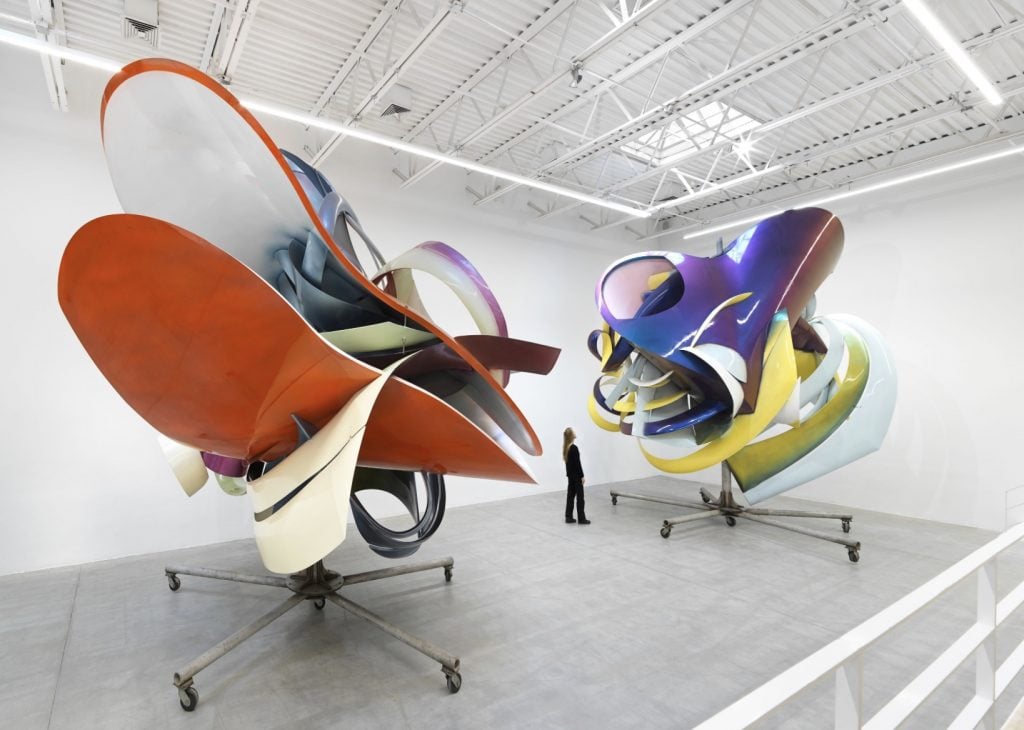
Installation view of “Frank Stella: Recent Sculpture” at Jeffrey Deitch gallery. Photos by Genevieve Hanson. ©2024 Frank Stella / Artists Rights Society (ARS)
In a 2000 interview in Bomb, Saul Ostrow asked Stella about the desire that so many people have expressed over the years for him to return to his minimal, predictable language. “The whole idea of art is to be open,” the artist replied, “to be generous, and absorb the viewer and absorb yourself, to let them go into it.”
Stella was in his mid-60s at the time, and when Ostrow pushed him about critical reactions, the artist offered a little more. “It’s not an issue anymore,” he said. “When you’re looking ahead, I guess it’s a problem, but when you’re looking ahead and it’s not very far, you can’t really worry about those other things. Time is what you have left; you just march with it and use it the best you can.”
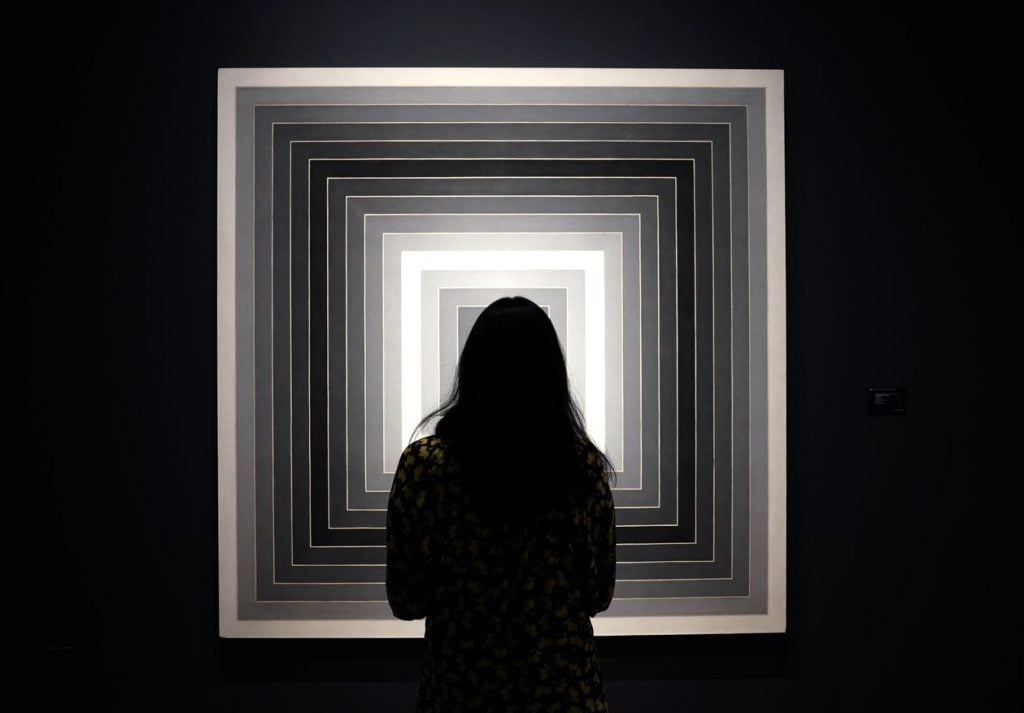
A woman looks at Frank Stella’s Sharpeville (1962) during a press preview of a Christie’s. Photo by Timothy A. Clary/AFP via Getty Images.